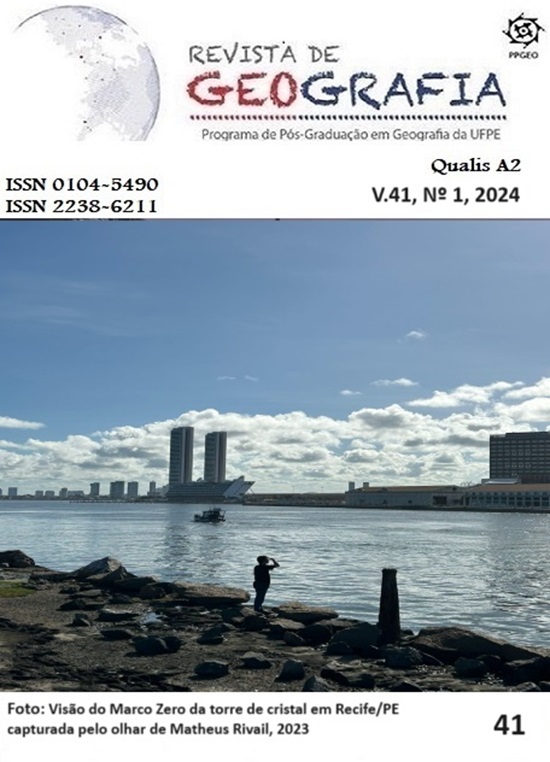Influence of the Rainfall Anomaly Index on vegetation in the Pajeú river basin watershed Through Remote Sensing
DOI:
https://doi.org/10.51359/2238-6211.2024.258619Keywords:
precipitation, Google Earth Engine, CHIRPS, EVI-2Abstract
Precipitation is one of the main components of the hydrological cycle and has a strong influence on terrestrial features, such as vegetation. The analysis of the relationship between precipitation variability and vegetation vigor through remote sensing plays a fundamental role in understanding the impacts of climate change on ecosystem dynamics. Based on this, the present article aims to quantify the Rainfall Anomaly Index (RAI) for the Pajeú River Watershed using precipitation data from the CHIRPS group, as well as to examine the vegetation response to these anomalies through the Enhanced Vegetation Index (EVI-2), quantified using reflectance data from the MOD09Q1 (Terra satellite) and MYD09Q1 (Aqua satellite) products. The sample correlation between RAI and EVI-2 yielded a correlation coefficient of r = 0.77, indicating that an increase in RAI (precipitation growth) directly contributes to increased vegetative vigor. However, the simple regression analysis yielded an R2 = 0.58, indicating that the relationship between the variables is not linear and that vegetation is influenced by other factors such as temperature and relative humidity. Finally, this study provides evidence of the effectiveness of RAI in analyzing rainfall anomalies, as well as EVI-2 in exploring vegetation health variability and terrestrial dynamics.
References
APAC – Agência Pernambucana de Águas. Atlas de Bacias Hidrográficas de Pernambuco (2006). Disponível em: https://www.apac.pe.gov.br. Acesso em 10 de maio de 2023.
ARAUJO, L. E.; MORAES NETO, J. M.; SOUSA, F. A. S. (2009). Análise Climática da Bacia do rio Paraíba – índice de Anomalia de Chuva (IAC). Revista de Engenharia Ambiental, v. 6, n. 3, p. 508-523.
ASNER, G. P., ANDERSON, C. B., MARTIN, R. E., KNAPP, D. E., KENNEDY-BOWDOIN, T., & VAN BREUGEL, M. (2016). Large-scale impacts of herbivores on the structural diversity of African savannas. Proceedings of the National Academy of Sciences, 113(2), 547-552.
BATES, B.C.; KUNDZEWICZ, Z.W.S. WU, S.; PALUTIKOF, J.P. (eds). Climate Change and Water, Technical Paper of the Intergovernmental Panel on Climate Change. Geneva: IPCC, 2008.
GLOOR, M.; BARICHIVICH, J.; ZIV, G. (2015), Recent Amazon climate as background for possible ongoing and future changes of Amazon humid forests. Global Biogeochemical Cycles, v. 29, p. 1384-1399, 2015.
HARGREAVES, G. H., HARGREAVES, G. H., & HARGREAVES, G. H. (2017). An assessment of the feasibility of global solar radiation estimation from NOAA-AVHRR data. Agricultural and Forest Meteorology, 93(3), 211-228.
JIANG, Z., HUETE, A. R., DIDAN, K., & MIURA, T. (2008). Development of a two-band enhanced vegetation index without a blue band. Remote Sensing of Environment, 112(10), 3833-3845.
MARENGO, J.A.; RUSTICUCCI, M.; PENALBA, O.; REMON, M. An Intercomparison of observed and simulated extreme rainfall and temperature events during the last half of the twentieth century: Part 2 - Historical trends. Climate Change, v. 98, n. 3, p. 509-529, 2010.
ROOY, M.P. van, 1965: A Rainfall Anomaly Index Independent of Time and Space, Notos,
, 43.
SILVA, J. S. S. et al. Análise da cobertura vegetal da bacia do rio Pajeú, Sertão de Pernambuco-PE. Revista Geonorte, v. 6, n. 1, p. 37-44, 2013.
TRENBERTH, K. E., DAI, A., RASMUSSEN, R. M., & PARSONS, D. B. (2014). The changing character of precipitation. Bulletin of the American Meteorological Society, 95(4), 403-418.
ZHAO, XIA; HU, HUIFENG; SHEN, HAIHUA; ZHOU, DAOJING; MYNENI, RANGA B.; FANG, JINGYUN (2015). Satellite-indicated long-term vegetation changes and their drivers on the Mongolian Plateau. Landscape Ecology, Vol. 30, 211-228.
Downloads
Published
How to Cite
Issue
Section
License
Copyright (c) 2024 Eduardo Gonçalves Patriota

This work is licensed under a Creative Commons Attribution 4.0 International License.
Autores que publicam nesta revista concordam com os seguintes termos:
a) Autores mantêm os direitos autorais e concedem à REVISTA DE GEOGRAFIA da Universidade Federal de Pernambuco o direito de primeira publicação, com o trabalho simultaneamente licenciado sob a Licença Creative Commons Atribuição 4.0 Internacional. CC BY -  . Esta licença permite que os reutilizadores distribuam, remixem, adaptem e criem a partir do material em qualquer meio ou formato, desde que a atribuição seja dada ao criador. A licença permite o uso comercial.
. Esta licença permite que os reutilizadores distribuam, remixem, adaptem e criem a partir do material em qualquer meio ou formato, desde que a atribuição seja dada ao criador. A licença permite o uso comercial.
b) Autores têm autorização para assumir contratos adicionais separadamente, para distribuição não-exclusiva da versão do trabalho publicada nesta revista (ex.: publicar em repositório institucional ou como capítulo de livro), com reconhecimento de autoria e publicação inicial nesta revista.
c) Autores têm permissão e são estimulados a publicar e distribuir seu trabalho online (ex.: em repositórios institucionais ou na sua página pessoal) a qualquer ponto antes ou durante o processo editorial, já que isso pode gerar alterações produtivas, bem como aumentar o impacto e a citação do trabalho publicado.
d) Os conteúdos da REVISTA DE GEOGRAFIA estão licenciados com uma Licença Creative Commons Atribuição 4.0 Internacional. CC BY -  . Esta licença permite que os reutilizadores distribuam, remixem, adaptem e criem a partir do material em qualquer meio ou formato, desde que a atribuição seja dada ao criador. A licença permite o uso comercial.
. Esta licença permite que os reutilizadores distribuam, remixem, adaptem e criem a partir do material em qualquer meio ou formato, desde que a atribuição seja dada ao criador. A licença permite o uso comercial.
No caso de material com direitos autorais a ser reproduzido no manuscrito, a atribuição integral deve ser informada no texto; um documento comprobatório de autorização deve ser enviado para a Comissão Editorial como documento suplementar. É da responsabilidade dos autores, não da REVISTA DE GEOGRAFIA ou dos editores ou revisores, informar, no artigo, a autoria de textos, dados, figuras, imagens e/ou mapas publicados anteriormente em outro lugar.


